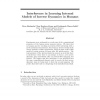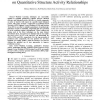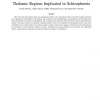1377 search results - page 237 / 276 » Neural Computing |
NIPS
1994
13 years 9 months ago
1994
Experiments were performed to reveal some of the computational properties of the human motor memory system. We show that as humans practice reaching movements while interacting wi...
CIBCB
2009
IEEE
13 years 8 months ago
2009
IEEE
Machine Learning techniques are successfully applied to establish quantitative relations between chemical structure and biological activity (QSAR), i.e. classify compounds as activ...
ACTAC
2006
13 years 7 months ago
2006
In this paper we introduce a statistical Named Entity recognizer (NER) system for the Hungarian language. We examined three methods for identifying and disambiguating proper nouns...
TNN
2008
13 years 7 months ago
2008
There have been many theories about and computational models of the schizophrenic disease state. Brain imaging techniques have suggested that abnormalities of the thalamus may con...
BC
2002
13 years 7 months ago
2002
Synchronously spiking neurons have been observed in the cerebral cortex and the hippocampus. In computer models, synchronous spike volleys may be propagated across appropriately co...



